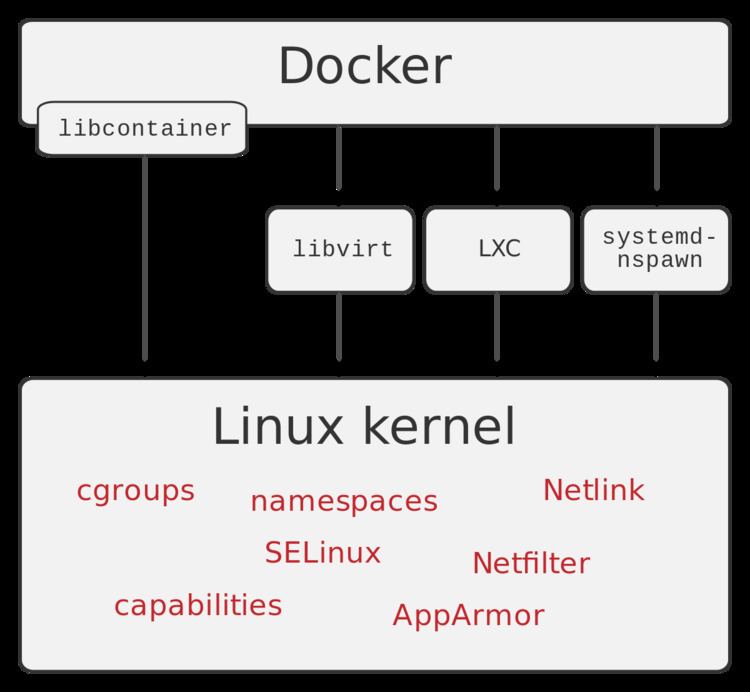Original author(s) Written in Go | Developer(s) Docker, Inc. | |
 | ||
Initial release 13 March 2013; 3 years ago (2013-03-13) Stable release 1.13.1 / 8 February 2017; 26 days ago (2017-02-08) Repository github.com/docker/docker | ||
Docker is an open-source project that automates the deployment of applications inside software containers. Quote of features from Docker web pages:
Contents
Docker containers wrap up a piece of software in a complete filesystem that contains everything it needs to run: code, runtime, system tools, system libraries – anything you can install on a server. This guarantees that it will always run the same, regardless of the environment it is running in.
Docker provides an additional layer of abstraction and automation of operating-system-level virtualization on Windows and Linux. Docker uses the resource isolation features of the Linux kernel such as cgroups and kernel namespaces, and a union-capable file system such as OverlayFS and others to allow independent "containers" to run within a single Linux instance, avoiding the overhead of starting and maintaining virtual machines.
The Linux kernel's support for namespaces mostly isolates an application's view of the operating environment, including process trees, network, user IDs and mounted file systems, while the kernel's cgroups provide resource limiting, including the CPU, memory, block I/O and network. Since version 0.9, Docker includes the libcontainer library as its own way to directly use virtualization facilities provided by the Linux kernel, in addition to using abstracted virtualization interfaces via libvirt, LXC (Linux Containers) and systemd-nspawn.
Overview
As actions are done to a Docker base image, union file system layers are created and documented, such that each layer fully describes how to recreate an action. This strategy enables Docker's lightweight images, as only layer updates need to be propagated (compared to full VMs, for example).
According to industry analyst firm 451 Research,
Docker is a tool that can package an application and its dependencies in a virtual container that can run on any Linux server. This helps enable flexibility and portability on where the application can run, whether on premises, public cloud, private cloud, bare metal, etc.
Docker implements a high-level API to provide lightweight containers that run processes in isolation.
Building on top of facilities provided by the Linux kernel (primarily cgroups and namespaces), a Docker container, unlike a virtual machine, does not require or include a separate operating system. Instead, it relies on the kernel's functionality and uses resource isolation (CPU, memory, block I/O, network, etc.) and separate namespaces to isolate the application's view of the operating system. Docker accesses the Linux kernel's virtualization features either directly using the libcontainer library, which is available as of Docker 0.9, or indirectly via libvirt, LXC (Linux Containers) or systemd-nspawn.
Because Docker containers are so lightweight, a single server or virtual machine can run several containers simultaneously. A 2016 analysis found that a typical Docker use case involves running five containers per host, but that many organizations run 10 or more.
By using containers, resources can be isolated, services restricted, and processes provisioned to have an almost completely private view of the operating system with their own process ID space, file system structure, and network interfaces. Multiple containers share the same kernel, but each container can be constrained to only use a defined amount of resources such as CPU, memory and I/O.
Using Docker to create and manage containers may simplify the creation of highly distributed systems by allowing multiple applications, worker tasks and other processes to run autonomously on a single physical machine or across multiple virtual machines. This allows the deployment of nodes to be performed as the resources become available or when more nodes are needed, allowing a platform as a service (PaaS)-style of deployment and scaling for systems like Apache Cassandra, MongoDB or Riak. Docker also simplifies the creation and operation of task or workload queues and other distributed systems.
Integration
Docker can be integrated into various infrastructure tools, including Amazon Web Services, Ansible, CFEngine, Chef, Google Cloud Platform, IBM Bluemix, HPE Helion Stackato, Jelastic, Jenkins, Kubernetes, Microsoft Azure, OpenStack Nova, OpenSVC, Oracle Container Cloud Service, Puppet, Salt, Vagrant, and VMware vSphere Integrated Containers.
The Cloud Foundry Diego project integrates Docker into the Cloud Foundry PaaS.
Red Hat's OpenShift PaaS integrates Docker and related project (Kubernetes, Geard, Project Atomic and others) since v3 (June 2015).
The Apprenda PaaS integrates Docker containers in version 6.0 of its product.
History
Solomon Hykes started Docker in France as an internal project within dotCloud, a platform-as-a-service company, with initial contributions by other dotCloud engineers including Andrea Luzzardi and Francois-Xavier Bourlet. Jeff Lindsay also became involved as an independent collaborator. Docker represents an evolution of dotCloud's proprietary technology, which is itself built on earlier open-source projects such as Cloudlets.
Docker was released as open source in March 2013. On March 13, 2014, with the release of version 0.9, Docker dropped LXC as the default execution environment and replaced it with its own libcontainer library written in the Go programming language. As of October 24, 2015, the project had over 25,600 GitHub stars (making it the 20th most-starred GitHub project), over 6,800 forks, and nearly 1,100 contributors.
A May 2016 analysis showed the following organizations as main contributors to Docker: The Docker team, Cisco, Google, Huawei, IBM, Microsoft, and Red Hat.
A January 2017 analysis of LinkedIn profile mentions showed Docker presence grew by 160% in 2016.
